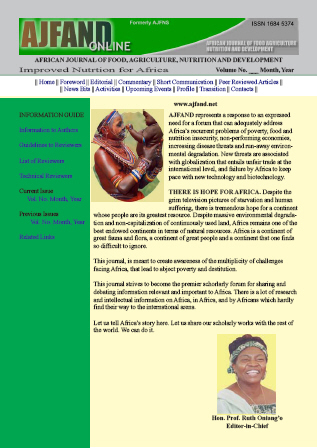
|
African Journal of Food, Agriculture, Nutrition and Development
Rural Outreach Program
ISSN: 1684-5358
EISSN: 1684-5358
Vol. 20, No. 6, 2020, pp. 16652-16668
|
 Bioline Code: nd20098
Bioline Code: nd20098
Full paper language: English
Document type: Research Article
Document available free of charge
|
|
|
African Journal of Food, Agriculture, Nutrition and Development, Vol. 20, No. 6, 2020, pp. 16652-16668
| en |
HOUSEHOLD FOOD CONSUMPTION AND NUTRITIONAL STATUS OF CHILDREN AGED 6 TO 59 MONTHS IN ZINDER, NIGER REPUBLIC
Oumarou, DH; Issaka, HA & Balla, A
Abstract
Malnutrition exists in both urban and rural areas in Niger. An analysis of food and
nutrition situation was carried out in the urban municipality of Zinder in order to
contribute to a better understanding of the situation. This work was done from February
to March 2018, at the household level, sampled by probabilistic method. The study
involved 168 children from 6 to 59 months selected from 150 households in
15neighborhoods in the urban municipalities of Zinder. An analysis of the Food
Consumption Score and Household Food Diversity Score showed acceptable food
consumption and high food diversity respectively in58.7% and 67.3% of households. Furthermore, the results showed that the socio-economic characteristics that determined
Score of food consumption were the main activities of heads of households and their
wives. Food diversity was generally acceptable, although 2.7 % of households still had
low dietary diversity in the study area. Also, food diversity remained low overall for
nearly 8.9% of children with a rate of 6.0% for households headed by a woman.
Nevertheless, the latter female-headed households had an estimated 13.7% of children
with average individual food diversity. The prevalence of acute global malnutrition is
13.1% with the severe form at3%. It should be noted that girls were much more affected
by this severe form (3.4%) compared to 2.5% for boys. However, stunting was more
prevalent in males than in females with 57.5% and 46.6%,respectively. Moderate form
accounting for 28.4% in females compared to 17.5% in males. This nutritional status
reflects the relatively acceptable food situation in which these children lived.
Furthermore, the appreciation of different foods and modes of consumption have shown
on the one hand that the diet remains monotonous. On the other hand, this analysis
revealed that cereal-based dishes accompanied by vegetable/leafy sauces predominated
in these households in the study area. This situation exposes the members of these
households and especially young children to the risk of malnutrition.
Keywords
Characterization; food consumption; food diversity; nutritional status; children; household; socioeconomics; Zinder
|
| |
© Copyright 2020 - African Journal of Food, Agriculture, Nutrition and Development
Alternative site location: http://www.ajfand.net/
|
|
